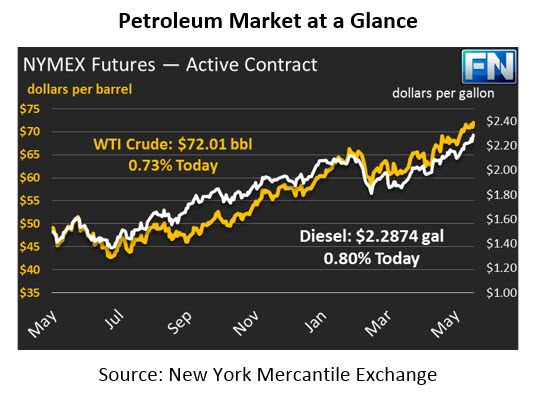
Brent Crude Hits $80/Bbl
Oil prices are continuing their ascent higher, led by Brent (international) crude prices, which have risen faster relative to WTI (American) crude. WTI crude prices stayed relatively flat yesterday following a benign EIA report, but this markets are showing their continued fear of the Iran nuclear deal withdrawal announced by Trump last week. WTI crude prices are currently $72.01, trading 52 cents (0.7%) above yesterday’s close.
Fuel prices are also pushing new highs. Diesel prices got a solid boost of 2 cents yesterday, while gasoline saw a significant 4.5 cent rally following the EIA report. Today, prices are continuing to push higher. Diesel prices are currently $2.2874, up 1.8 cents (0.8%) since yesterday’s close. Gasoline prices are $2.2569, a less notable gain of 0.7 cents (0.3%).
Brent Hits $80/bbl
This morning, for the first time since November 2014, Brent crude oil briefly exceeded $80/bbl in early morning trading. Reuters noted this morning that this price peak comes after 500 days and almost a billion barrels of sacrificed production by OPEC.
Typically trading at a $4-$5 premium, Brent crude oil is trading well over $7/bbl higher than WTI. With Iranian oil production threatened, as well as plummeting volumes from Venezuela, non-US oil production is becoming scarce.
WTI production is plenteous, meaning that WTI prices need not rally. On the other hand, Brent crude oil, produced in Europe, is the index of choice for the majority of crude oil sold in the world, and with production falling elsewhere it will be in strong demand. The rising Brent/WTI spreads points to growing fear among traders that oil prices will soar, even if the U.S. continues to increase production.
EIA Inventory Data Fails to Impress
The EIA released their weekly inventory data yesterday, and the numbers were quite docile. While the API showed a huge crude oil draw, the EIA’s data showed draws in line with market expectations.
Gasoline was the outlier, with EIA reporting stocks falling 3.8 million barrels, 2.5x the market’s expected gasoline draw. Correspondingly, gasoline saw the largest price gains yesterday, as traders gear up for a busy summer driving season. With the economy running on all cylinders, many drivers are expected to hit the roads this year during summer breaks. Gasoline imports fell by 100 Kbpd, while exports were 2.5 Million barrels higher than the previous week, overall suggesting strong international demand for oil and signaling higher prices.
Refineries are beginning to spring back into action, with Midwest refineries reaching 98.7% of refinery utilization. Midwest refineries, working with cheap Canadian and Bakken crudes, have grown in their production capacity and importance over the past few years, so the high utilization is notable. In contrast, the Gulf Coast – the traditional refining hub for the U.S. – has utilization rates of 89.1%, half a percent lower than last week.
This article is part of Crude
Tagged:
MARKET CONDITION REPORT - DISCLAIMER
The information contained herein is derived from sources believed to be reliable; however, this information is not guaranteed as to its accuracy or completeness. Furthermore, no responsibility is assumed for use of this material and no express or implied warranties or guarantees are made. This material and any view or comment expressed herein are provided for informational purposes only and should not be construed in any way as an inducement or recommendation to buy or sell products, commodity futures or options contracts.







